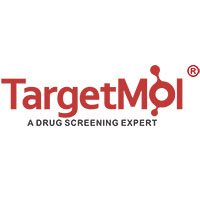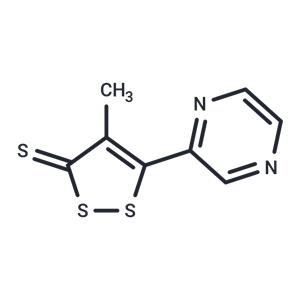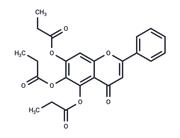| Name | Oltipraz |
| Description | Oltipraz (RP 35972) is a synthetic dithiolethione with potential chemopreventive and anti-angiogenic properties. Oltipraz induces phase II detoxification enzymes, such as glutathione S transferase (GST) and NAD(P)H: quinone oxidoreductase 1 (NQO1). The induction of detoxification enzymes enhances the detoxification of certain cancer-causing agents, thereby enhancing their elimination and preventing carcinogen-induced DNA damages. Although the exact mechanism through which the anti-angiogenesis effect remains to be fully elucidated, oltipraz maybe able to modulate the expression of a number of angiogenic factors, thereby blocking the sustained and focal neovascularization in multiple tumor cell types. |
| Kinase Assay | The Src and Abl kinase assays: The Src kinase activity is measured in an ELISA format. Src (3 units/reaction), reaction buffer (50 mM Tris-HCl pH 7.5, 10 mM MgCl2, 0.1 mM EGTA, 0.5 mM Na3VO4) and cdc2 substrate peptide are added to various concentration of Bosutinib and incubated at 30 °C for 10 minutes. The reaction is started by the addition of ATP to a final concentration of 100 μM, incubated at 30 °C for 1 hour and stopped by addition of EDTA. Instructions from the manufacturer are followed for subsequent steps. The Abl kinase assay is performed in a DELFIA solid phase europium-based detection assay format. Biotinylated peptide (2 μM) is bound to streptavidin-coated microtitration plates for 1.5 hours in 1 mg/mL ovalbumin in PBS. The plates are washed for 1 hour with PBS/0.1% Tween 80, followed by a PBS wash. The kinase reaction is incubated for 1 hour at 30°C. Abl kinase (10 units) is mixed with 50 mM Tris-HCl (pH 7.5), 10 mM MgCl2, 80 μM EGTA, 100 μM ATP, 0.5 mM Na3VO4, 1% DMSO, 1 mM HEPES (pH 7.0), 200 μg/mL ovalbumin and various concentration of Bosutinib. The reaction is stopped with EDTA at a final concentration of 50 mM. The reaction is monitored with Eu-labeled phosphotyrosine antibody and DELFIA enhancement solution. |
| In vitro | Oltipraz, as a chemoprotective agent, induces Phase II detoxification enzyme activity in a Nrf2-dependent manner. [1] In human HT29 colon cancer cells, oltipraz inhibits the induction of HIF-1α by insulin, hypoxia or CoCl2 by significantly accelerating degradation of HIF-1α protein. [2] |
| In vivo | Oltipraz (500 mg/kg, p.o.) significantly reduces multiplicity of gastric neoplasia in wild-type mice by 55%, but has no effect on tumor burden in nrf2-deficient mice. [1] In BALB/c nude mice transplanted with HCT116 cells, Oltipraz (200 mg/kg, p.o.) inhibits tumor growth and angiogenesis via inhibition of HIF-1α. [2] In rats on a CDAA diet, Oltipraz attenuate the progression of nonalcoholic steatohepatitis-related fibrosis. [3] |
| Storage | Powder: -20°C for 3 years | In solvent: -80°C for 1 year | Shipping with blue ice. |
| Solubility Information | DMSO : 15 mg/mL (66.27 mM), Sonication is recommended.
|
| Keywords | Inhibitor | HIF/HIF Prolyl-Hydroxylase | Oltipraz | Keap1-Nrf2 | RP35972 | inhibit | HIFs | Human immunodeficiency virus | HIV | Hypoxia-inducible factors | NSC347901 | NSC-347901 | RP-35972 | HIF-PH |
| Inhibitors Related | Stavudine | 5-Fluorouracil | Emtricitabine | Lamivudine | Curcumin | Hydroxycitric acid tripotassium hydrate |
| Related Compound Libraries | Anti-Lung Cancer Compound Library | Anti-Neurodegenerative Disease Compound Library | Bioactive Compound Library | Anti-Cancer Clinical Compound Library | Anti-Viral Compound Library | Drug Repurposing Compound Library | Anti-Aging Compound Library | Bioactive Compounds Library Max | Anti-Cancer Drug Library | Anti-Cancer Active Compound Library |

 United States
United States



